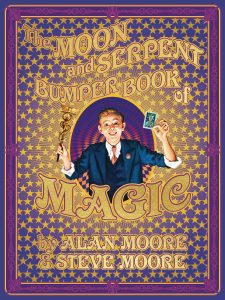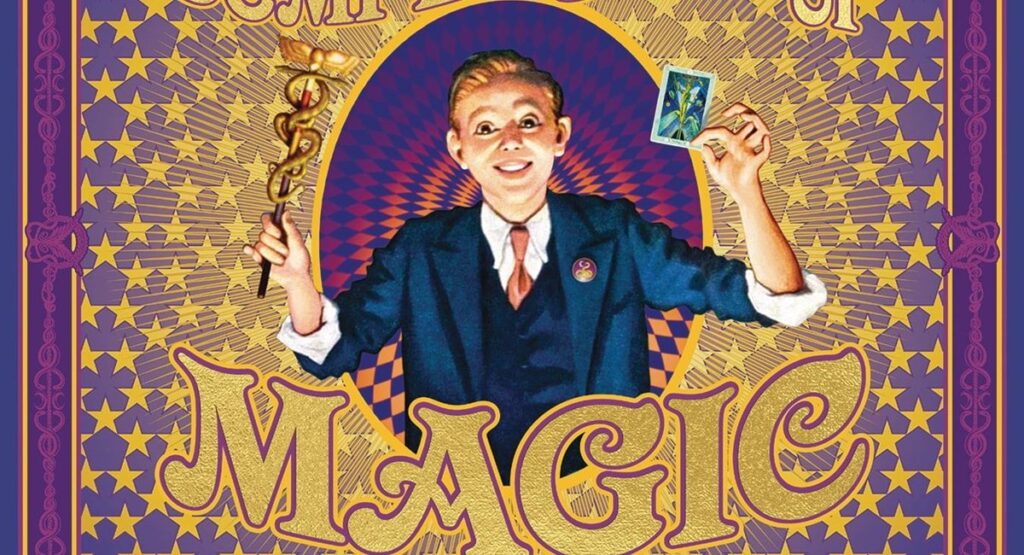


 Moon and Snake Bumper Magic Book
Moon and Snake Bumper Magic Book
writer: Alan Moore, Steve Moore
artist: Steve Parkhouse, Rick Veitch, Kevin O’Neill, Ben Wickie, John Coulthart
Publisher: top shelf production
Publication date: October 2024
I think we’ve all had that experience: reality doesn’t feel real. In moments of pain, and sometimes even in the midst of great joy, we need to remind ourselves that what is before us In fact it does exist. “Pinch me, I’m dreaming.” Whether we feel like we are in a dream or a nightmare, the dissonance between our physical existence and our self-awareness of these situations means that there is a gap between the real world and the spiritual world. A rather unstable and tense relationship.
People have speculated about the relationship between the world and our consciousness, between the mind and our bodies, since the birth of consciousness itself and of philosophies that might question this relationship. It’s a tricky thing to thread the needle between the real world and the spiritual world without losing sight of exactly how one world needs the other.
However, it is these problems Alan Moore, Steve Moore and their artistic collaborators the gallery is trying to Moon and Snake Bumper Magic Book. Alan Moore’s mentor and close friend Steve Moore died in 2014, the artist Kevin O’Neillwho also appears here, died in 2022. bumper book So it’s been a research and a hard life’s work of a very talented group of people trying to study magic and its relationship to consciousness.
To be clear, Moon and Snake Bumper Magic Book not graphic novel. The book has been called a “magical book of occult sciences,” meaning that its contents are not strictly a narrative and need to be read in one sitting. While comics are included, they serve the larger ambition of the book, which is to be a historical and practical guide to magic, and Steve and Alan Moore (Moore2) is called “the science of consciousness.” So the reading experience should be more akin to absorbing a few pages of theory, sitting with you for however long it takes to think about its implications, and then moving on to learn about the history of magic with exercises you can try at home or an illustrated story about the history of magic . This is less a graphic novel than a picture textbook or a picture philosophy treatise.
So, in order to understand this article, I think it’s best to look at the book like a philosophy. One of my mentors once told me: “Every philosophical text is an answer to a question or a solution to a problem. What is the problem? What is the problem? So, in these terms, we first need to understand what Moore proposed What exactly is the problem?2 It seems to be wrestling.
We’re lucky, Moore2 We are asked these questions at the beginning of this book:
- “How do we situate this vital and potentially mysterious realm of the psyche?
- “How can we find a door that probably didn’t exist, or even if it did exist but was later obscured by the Age of Reason?”
- “Even if we stumbled upon the entrance to such a magical experience, how could we recognize a place so foreign?”
- “What do we do once we find the magic?”
It is from here that bumper book Take us on a journey to understand not only where these questions come from, but what might be gained by trying to answer them. Ultimately, this is not about giving a concrete answer from a scientific perspective. Instead, developing a system or way of thinking can help us ask these questions in the first place. The world and our thoughts are not taken for granted, for it is only through thought that we can acknowledge that the world exists. So, what kind of power lurks behind our mysterious consciousness?
- How do we situate this crucial and potentially mysterious realm of the psyche?
Moore2 No stranger to skepticism, to his credit; bumper book The intention is not to draw conclusions for granted, but to make concrete arguments based on the evidence collected. So the “problem” or “problem” of this article is primarily based on the dissonance between our conscious experience and the nature of the world at large; we talked about these moments at the top of this review where it seems that what we believe to be true and real seems is conflicting.
this bumper book Start with comics Steve Parkhousethen another by Rick Veitch. The first movie-like opening scene 2001: A Space Odyssey The simple impulses of nature are disrupted by the creation of something beyond the full comprehension of our cognitive abilities at the time. Reality is altered by something that seems contradictory, or at least takes us out of our immersion in the world. As discussed in the second comic, this power eventually became the idea story. Stories are fundamentally about representation. Therefore, Moore2 wrote that “Appearance alone distinguishes humans from other animals, allowing access to a conceptual world in which all phenomena, including the mind itself, inevitably appear magical.” This early claim of separation grasping heartand The conceptual world we need to master Similar to the classical form of dualism. It is similar to Plato’s description of the representation of concepts in the world and the forms we seek to represent. But unlike Plato, Moore2 To me, don’t read like a dualist like a phenomenologist.
- How can we find that door that may not have existed, or even if it did exist but was later obscured by the Age of Reason?
The capacity for expression, or the mechanism that provides access to the conceptual world that makes art and magic possible, lies within the interpretation of our own mind and the world it perceives. Here they propose a “region of consciousness that allows us to have so-called magical experiences,” which are parts of the mind “that we cannot fully access under normal circumstances.” In the case of phenomenology, the main concern is with how subjective engagement with the objects within our field of vision enables us to instantiate the existence of the wider world bit by bit. Or, as Moore2 Here it is written: “The mind is not only the source of all artifacts on earth, but also the only means by which humans connect to reality. Unable to directly experience the universe, we rely on perceptions interpreted by consciousness to construct the world around us moment by moment. This As both a method and an argument, your ability to be a good phenomenologist, shaman, or magician depends on how well you follow the transcendental reduction by “bracketing” your perceptions and building a broader understanding from them. process. Once we have the ability to do this, we can begin to create a world that may not seem real to others. At least not until they take these steps with us.
- Even if we stumble upon the entrance to such a magical experience, how would we recognize a place so foreign?
The closest expression of magic, the embodiment of a magical realm, that we have is art. “Therefore, all art has magic from the beginning, and the magic is the art itself.” This is true not only because of its ability to create representations, but also because of what it reveals to us about our own consciousness. As one will notice when reading bumper bookMoore2 It seems impossible to express the idea of magic without using the device of story. This is not a problem or limitation, but a proof of concept. “…in order for the imagination to conceive of this elusive realm of insubstantiality, it is necessary to use metaphor, which is as valuable a magical tool as poetry. This perhaps suggests that art and magic may have many properties in common, and may even ultimately be Same thing.
Another way to think about it is that I had a hard time understanding this book, in fact when I read it I wasn’t even sure I liked it that much. As I said, this is a textbook, not a graphic novel, or at least that’s how I understand it. But when writing about bumper bookin the ability to take the words and piece together a larger framework that suited my experience and creative abilities, the entire grimoire felt as though it unlocked for me. At that moment, I felt like a magician because this review “…once it’s done, it’s [my] The first willing, conscious act of magic. This is why I say don’t sit down and read this book in one sitting. Instead, spend time away from it, consider its content, practice its rituals, and find its use in your ability to navigate the world. Only in this way can its power be maximized.
Magic as representation and art as representation share a condition, or common property, such as metaphor, that illustrates to the reader that it is not just about perceiving the book in front of you, but about constructing it in a way that is unique to you and you. field of consciousness.
- Once we find the magic, what do we do?
This means that people should approach bumper bookand all philosophical writings, with an open mind. As my mentor once said, “If you like what you read, read it again. If you don’t like what you read, read it again. We may be keen to let our instincts drive our appreciation of what we read. beliefs about things, or lead us away from conceptual work that is just Sitting wrongwhatever that means. But the truth is, both magic and storytelling take work. One must invest effort, whether through writing or rereading, to understand what is before us.
Moore’s power2 What is said is not given to us, but is the result of our critical and disinterested engagement with the material before us. Once we develop these skills, we have the ability to exercise our awareness in ways that change our experience and the world at large. But we should not put the cart before the horse, and we should not open the book thinking that we can achieve our goals by simply drawing conclusions. This is not a “how to” guide of any kind. Like all art, it’s an example, not a blueprint. The end goal should always be a better understanding of self and respect for the forces of consciousness that shape our worldview. Or, as Moore2 One last time. “Whether you are an artist or a magician, you must first pay attention to the sounds of the inner world, and secondly the sounds of the outer world. Free yourself from low material intentions by committing yourself to a magical form of expression. Form requires us to practice art for art’s sake, not art for ourselves.
Moon and Snake Bumper Magic Book It’s not an easy thing to read, nor an easy thing to write. I think those who are more inclined to debate Moore2The idea of magic, or how it aligns with Alan Moore’s anarchist political tendencies, may find something particularly rich here. For the rest of us, however, it’s an interesting experience at best, an opportunity to delve into a richer psychology than we’re used to. For this reason, I think it’s worth reading. If you’re interested in dissecting a writer’s work through this guide, or if you have the patience to apply these rituals to yourself, you’ll find some amazing stuff here.
The Moon and the Snake Magic Book is now available.
Read more Comments from Beats!



